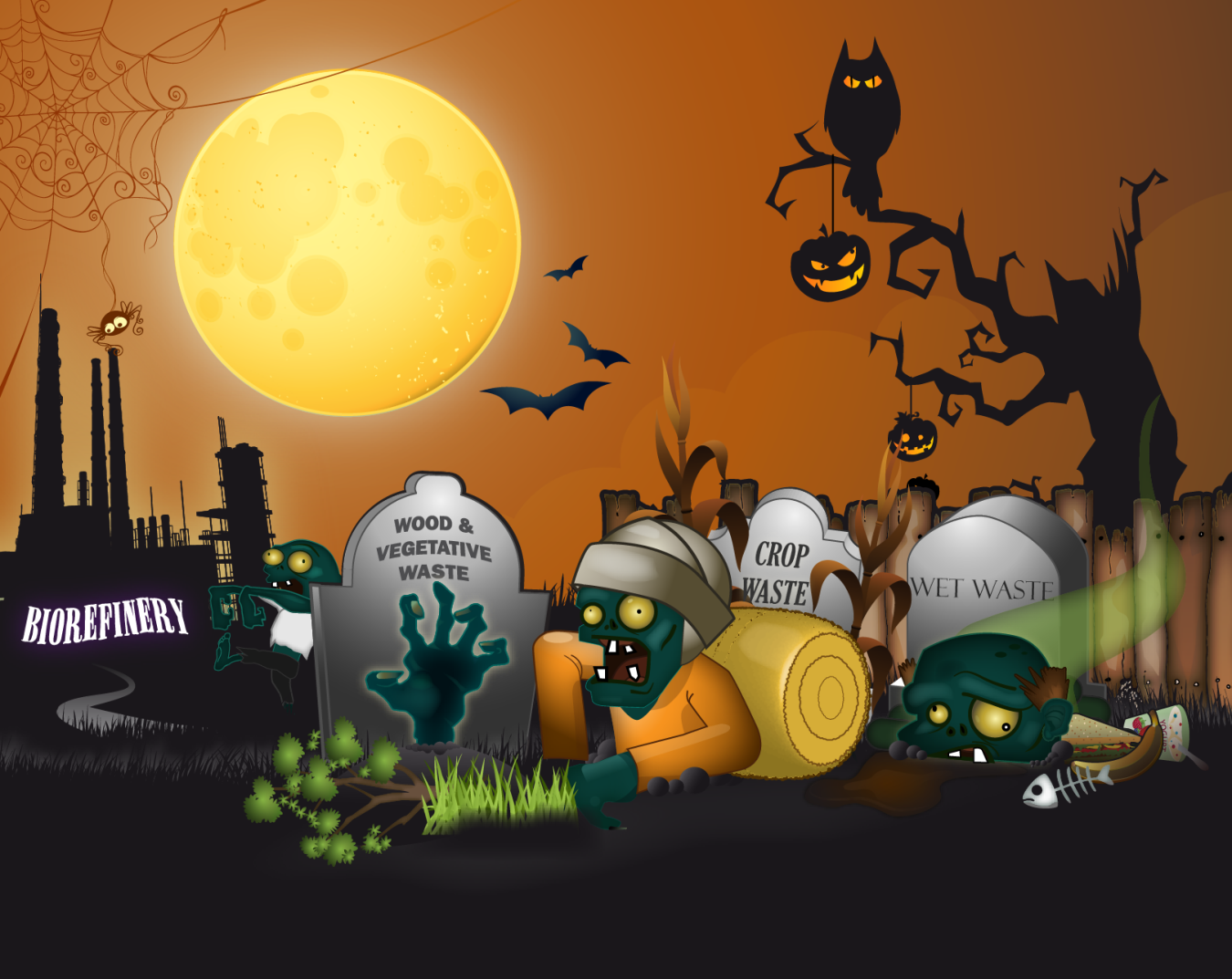
This Halloween season, the U.S. Department of Energy’s Bioenergy Technologies Office (BETO) is highlighting how waste can be “brought back to life” and turned into something useful. On average, Americans generate over 200 million tons of waste per year, or nearly 4.38 pounds per person per day. Significant opportunity exists to convert this and other waste sources into liquid transportation fuels.
“Waste to energy” is already happening today to generate heat and power. Many waste treatment facilities burn organic solid waste to create steam for generating electricity, while others utilize gases, such as biogas, derived from the decomposition of organic material in landfills. This month, DC Water’s Blue Plains Advanced Wastewater Treatment Plant in Washington, D.C. unveiled the first waste-to-energy facility in North America that utilizes novel thermal hydrolysis technology to convert sewage waste into energy through a combined heat and power system.
BETO is exploring the use of waste feedstocks to produce sustainable, cost-competitive biofuels, in addition to heat and power. Our work involves several waste feedstocks, including wet waste, wood and vegetative waste, and crop waste.
Wet wastes are a potential high-impact resource for domestic production of biogas. Wet waste is industrial, commercial, and residential food waste, as well as municipal waste water, animal manure, landfill gas, and liquid residue from sewage treatment. BETO is seeking to broaden biogas potential beyond electricity to produce biofuels and bioproducts. Specifically, the methane and carbon dioxide components of biogas are key chemical intermediates that could be converted to “drop-in” hydrocarbon fuels (that is, they can be a direct replacement for petroleum fuel). BETO held a stakeholder workshop in November 2014 to explore pathways for research, development, and demonstration of biofuels from wet wastes. BETO will next focus on examining the feasibility of producing transportation fuels from these underutilized, yet readily available feedstocks and developing robust conversion technologies for diverse waste streams.
Wood and vegetative wastes include lumber mill chips and sawdust, dead trees, leaves, and grass clippings. Crop wastes are the leftover material from crops, such as the stalks, leaves, and husks of corn plants. Vegetative wastes and crop wastes are the raw material for several commercial-scale cellulosic ethanol biorefineries constructed with the support of BETO funding. INEOS Bio’s biorefinery in Vero Beach, Florida, uses wood and vegetative waste, including palm fronds. POET-DSM’s Project LIBERTY and Abengoa’s Bioenergy Biomass of Kansas both use agricultural waste (leftover corn stalks, leaves, and husks). The Energy Department has also partnered with the U.S. Departments of Defense and Agriculture to begin construction on three biorefineries that will have the capacity to produce drop-in biofuels for military and commercial airplanes. All three of these biorefineries are designed to use waste feedstocks: fats, oils, and greases at the Emerald Biofuels biorefinery on the Gulf Coast; municipal solid waste at the Fulcrum Bioenergy plant in McCarran, Nevada; and wood waste (the byproducts of forest management) at the Red Rock Biofuels biorefinery in Lakeview, Oregon.
Technologies that enable sustainable, nationwide production of waste-based biofuels could provide a wealth of benefits, including job creation, energy security, and reduced petroleum imports. They could also help alleviate two of the world’s most pressing environmental issues: sustainable waste management and global climate change. Like a zombie, emerging waste-to-energy technologies could help take a big bite out of both.
Dr. Valerie Sarisky-Reed

Dr. Valerie Sarisky-Reed is the director of the Bioenergy Technologies Office (BETO) in the Office of Energy Efficiency and Renewable Energy (EERE). In this role, she manages efforts to improve performance, lower costs, and accelerate market entry of bioenergy technologies. She assists in overseeing strategic planning to meet aggressive goals covered by the BETO research and development budget of approximately $250M annually, working with the U.S. Department of Energy's (DOE) national laboratories, academia, and industry.
Valerie has more than 30 years of experience in addressing energy and environmental issues faced by the United States and globally. In addition to her programmatic activities, she is a founding member of the Metabolic Engineering Working Group, chartered by the Biotechnology Research Subcommittee, an inter-agency coordinating committee under the Office of Science and Technology Policy.
She also spent two years serving the chief scientist at the U.S. Department of Agriculture, helping to build bridges between DOE and the U.S. Department of Agriculture in support of the bioeconomy.
She also served as acting director for EERE's Wind Energy Technologies Office, where she enabled the development of the most recent Multi-Year Program Plan, which focused heavily on bringing offshore wind to the United States.
The Bioenergy Technologies Office current focus areas include scaling up renewable hydrocarbon fuel technologies with an emphasis on sustainable aviation fuels and on the recycle and upcycle of plastics through DOE’s Plastics Innovation Challenge which aims to reduce ocean-bound plastic waste.
Valerie holds a Ph.D. in biochemistry from Georgetown University and is a graduate of the U.S. Department of Commerce’s Senior Executive Service Career Development Program.

